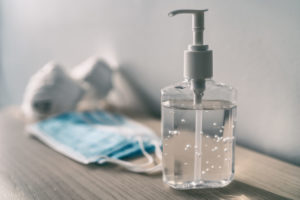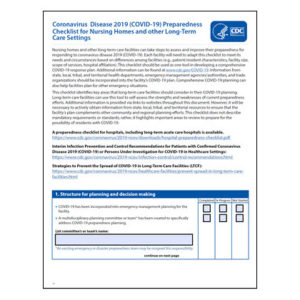Strategies Facilities Can Use to Optimize Their Current PPE Supply

John Sganga, senior vice president of alternate site programs, Premier
With personal protective equipment (PPE) playing an integral role in both the prevention and the management of COVID-19 outbreaks, the PPE supply within the United States has been stretched thin. Unfortunately, this challenge is prevalent in every industry, including in senior care facilities.
Premier Inc. surveyed nearly 2,500 skilled nursing and assisted living facilities from March 30 through April 7, 2020. The survey results were sobering: 24% of the surveyed facilities don’t have N95 masks on hand, and most facilities have less than a two-week supply of important PPE items like surgical masks, isolation gowns, and face shields.
Seventy percent of the facilities noted that they aren’t prepared to treat the increase in COVID-19 cases that may come with virus surges, and facilities are also experiencing supply concerns around items including thermometers, exam gloves, alcohol pads, soap, detergent, and hand sanitizer.
A May 2020 IASC survey revealed similar concerns and supply shortfalls; click here to get a copy of the executive summary.
With PPE in short supply, facilities increasingly need to conserve their existing stock and find creative ways to source additional supplies.
Strategies to Conserve PPE
According to the Centers for Disease Control and Prevention, facilities can use a number of strategies to help make existing PPE supplies last longer:
Reuse Respirators
The CDC notes that the COVID-19 virus can survive on plastic, stainless steel, and cardboard for up to 72 hours, but strategic handling of N95 masks and other filtering facepiece respirators can allow for their safe reuse. While decontamination procedures exist, the following method allows for reuse without decontamination:
- Issue five respirators to staff who care for patients who are suspected or confirmed to have COVID-19.
- Have staff wear one respirator each day before putting it into a breathable paper bag at the end of each shift.
- Rotate the use of the respirators so that each respirator is stored for at least five days between every use.
If a facility doesn’t have enough masks to provide staff with five masks, then decontamination and cleaning will be necessary. It’s important to consult the respirator manufacturer to clarify an appropriate decontamination and cleaning method that won’t damage the respirator’s performance.
Consider Isolation Gown Alternatives
The CDC recommends a variety of options to extend a supply of isolation gowns and surgical gowns:
- Prioritize surgical gowns for sterile procedures and rely on other gowns, like nonsterile, disposable gowns, for other procedures.
- Consider using cloth gowns, when appropriate, since they can be washed and reused.
- Consider using coveralls as an alternative to gowns.
- Prioritize gown use for high-contact activities like dressing, bathing, changing linens, and wound care.
Ensure Staff are Properly Trained
Taking the time to train all staff in how to appropriately put on and remove PPE can help to maximize its effectiveness and minimize the chances of staff needing additional PPE during a shift because of inappropriate use. The CDC offers detailed guidance and illustrations on how to put on and remove PPE. Facilities can print and post these guides in their locker rooms and other areas. The CDC’s PPE fact sheet is available in English, Spanish, Ukrainian, and Tagalog.
Implement Detailed Supply Monitoring
Now, more than ever, facilities need to have accurate counts of their PPE inventory. If current inventory counts are inaccurate, facilities should take manual counts and create an updated inventory list. Facilities may also need to implement new inventory tracking procedures and share those with staff.
While an accurate inventory count will give facilities an idea of what they have in stock now, they also need to be able to predict how long those supplies will last. The CDC offers a free PPE Burn Rate Calculator that facilities can use to determine their average consumption rate, or burn rate, for each type of PPE used. An understanding of both current inventory and burn rates can help facilities to better determine which supplies they most need to order and which conservation methods, like reusing masks, they may need to implement.
Strategies to Source Additional PPE
Even with careful conservation, current PPE supplies will only go so far, and facilities will need to be resourceful in identifying supplies of new PPE. If facilities’ current suppliers are out of PPE, there are other resources available.
John Sganga, Senior Vice President of Alternate Site Programs at Premier, notes that Premier launched stockd. in 2019 to help connect providers like skilled nursing facilities with reliable and trustworthy suppliers of products, including PPE. “We understand that skilled nursing facilities (along with most providers other than hospitals) have faced tremendous hurdles in getting PPE stemming from their lack of purchasing history. We launched stockd. to ensure that alternate sites of care, like senior living facilities, had access to buying protections, fair pricing and the reputability of items without price gouging,” states Sganga.
Premier also helped to found The Exchange at Resilinc in response to this problem. The Exchange is an online platform that healthcare providers can use to trade supplies with other organizations. “Peer organizations on the Exchange are vetted, so organizations know they’re dealing with trusted partners and can avoid the risks of the grey market. Solutions like this help move product to hotspots with the greatest need,” notes Sganga.
Facilities can also visit Premier’s resource page for providers who are facing PPE shortages. This page includes links to guidance on PPE decontamination and optimization strategies, but it also includes valuable alternative production methodologies and guidance, like face shield 3D printing information and dimensions for isolation gowns. If facilities are considering reaching out to local manufacturers, these resources provide detailed guidance that can empower facilities in sourcing direct manufacturing.
With PPE still limited, facilities need to assume an active role in optimizing current supplies and in sourcing new supplies. Facilities may need to be creative and resourceful to keep their staff stocked with the equipment they need during this time.

Paige Cerulli is a contributing writer to i Advance Senior Care.
Related Articles
Topics: Administration , Departments , Facility management , Featured Articles , Infection control , Leadership , Resident Care , Staffing , Surveys











